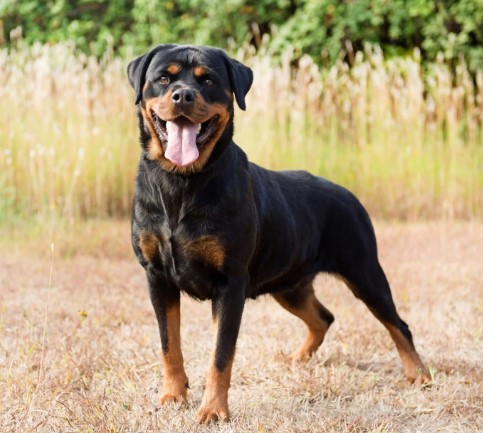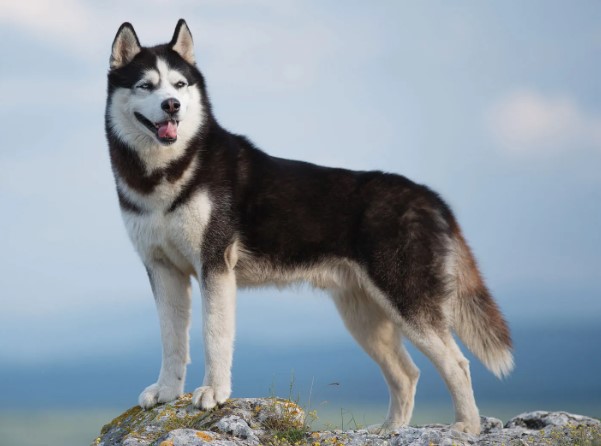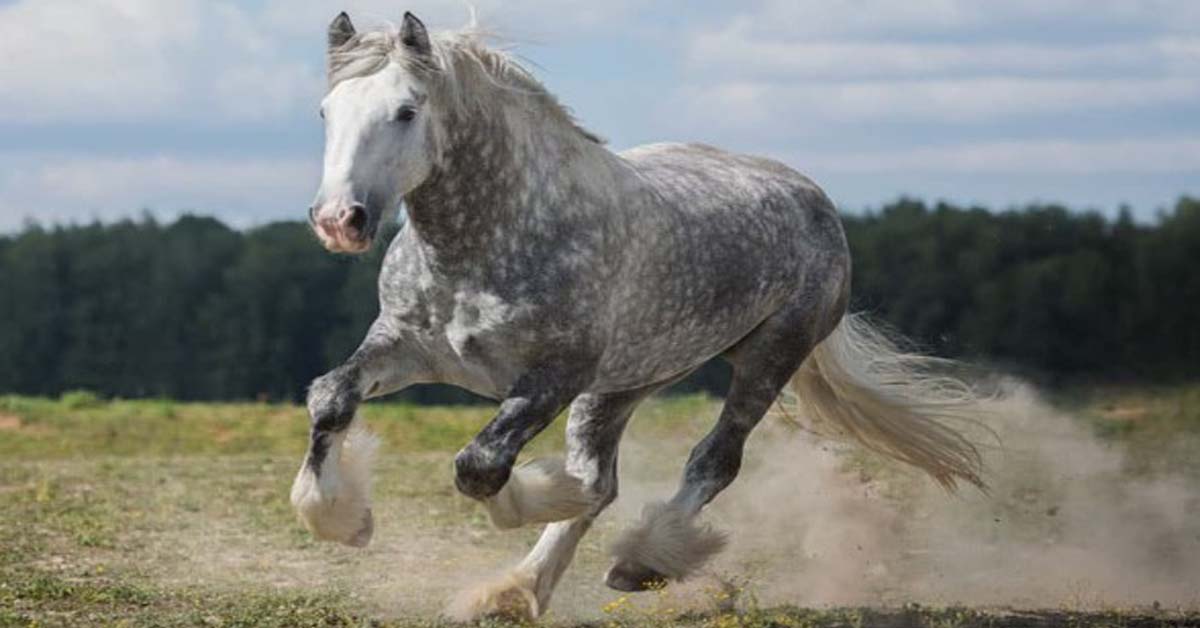The Texas Heeler is a mixed breed canine resulting from the crossbreeding of an Australian Cattle Dog, which is sometimes referred to as a Blue Heeler or Queensland Heeler, with an Australian Shepherd. This particular breed is renowned for its sharp intelligence, unwavering loyalty, and boundless energy. It is often enlisted as a proficient working dog, excelling in roles related to herding and cattle driving.
Moreover, the Texas Heeler exhibits remarkable prowess in agility and obedience training. This breed sports a short, sleek coat, typically adorned with blue or red speckles. In terms of physical attributes, they usually tip the scales at a range of 30 to 45 pounds and stand proudly between 18 to 22 inches in height at the shoulder. Furthermore, their lifespan extends from 12 to 15 years.
| Origin | United States |
| Weight | 30-45 pounds |
| Height | 18-22 inches |
| Lifespan | 12 – 15 years |
| Breed size | Medium (26-60 lbs) |
| Coat Color | Black, Brown, Blue, White |
Texas Heeler Breed Characteristics:
The Texas Heeler is the result of breeding between the Australian Cattle Dog, also known as the Blue Heeler or Queensland Heeler, and the Australian Shepherd. These dogs are characterized by their exceptional intelligence, boundless energy, and unwavering loyalty, making them outstanding candidates for various working roles. Their skillset extends to herding, mastering obedience training, and excelling in agility.
With a strong herding instinct, they display a protective nature towards their family and property. Their coat is typically short and dense, predominantly blue or blue merle in color, often adorned with white and tan markings. This medium-sized breed typically tips the scales at 30-45 pounds and stands proudly at 18-22 inches in height at the shoulder.
To keep them content and in optimal health, regular exercise and mental stimulation are essential for Texas Heelers.

Adaptability:
The Texas Heeler, alternatively recognized as the Australian Cattle Dog Heeler, is a breed celebrated for its exceptional adaptability. Originating from a heritage of ranch and farm work, these dogs thrive in rural or suburban settings with ample space for them to indulge in running and play.
Their reputation for high intelligence and trainability renders them versatile for various tasks. Moreover, their loyalty and protective instincts make them excellent choices for family companionship.
Nevertheless, their robust herding inclination may not align well with households featuring small children or other diminutive pets. It’s crucial to note that they demand consistent exercise and mental engagement to ensure their well-being and contentment.
| Adapts well to apartment living: 2/5 Point | Good for novice owners: 3/5 Point |
| sensitivity level: 3/5 Point | Tolerates being alone: 3/5 Point |
| Tolerates cold weather: 4/5 Point | Tolerates hot weather: 3/5 Point |
Friendship all around:
The Texas Heeler is the product of a crossbreeding between an Australian Cattle Dog, often called a Blue or Queensland Heeler, and an Australian Shepherd. Renowned for their sharp intellect, unwavering loyalty, and robust work ethic, these dogs make exceptional companions.
They are ideally suited for active families or individuals who relish outdoor pursuits like hiking, running, and herding. Moreover, they demonstrate compatibility with children and other pets. To ensure a well-mannered and contented companion, early socialization and training are crucial, as with any breed.
| Affectionate with family: 4/5 Point | Kid-friendly: 3/5 Point |
| Dog-friendly: 3/5 Point | Friendly towards strangers: 3/5 Point |
Health and fitness requirements:
The Texas Heeler, born of the union between an Australian Cattle Dog (also recognized as a Blue Heeler or Queensland Heeler) and an Australian Shepherd, inherits a blend of characteristics and traits from its parentage. Notably, this breed possesses a high energy level and an inherent need for consistent physical activity.
To cater to the Texas Heeler’s vitality, it is imperative to offer ample opportunities for exercise, encompassing extended walks, runs, invigorating hikes, and engaging playtime, including herding activities. Additionally, mental stimulation through training is essential to keep this breed intellectually engaged and to prevent potential mischievous behavior.
While generally robust, like all breeds, Texas Heelers may have susceptibility to specific health concerns. Responsible breeders take measures to screen their breeding stock for potential issues such as hip dysplasia, elbow dysplasia, and eye-related ailments.
To maintain the Texas Heeler’s overall health and well-being, it’s equally crucial to provide a high-quality diet and schedule regular veterinary check-ups.
| Amount of shading: 4/5 Point | Drooling potential: 2/5 Point |
| Easy for the groom: 3/5 Point | General health: 3/5 Point |
| Potential for weight gain: 5/5 Point | Size: 3/5 Point |
Trainability:
The Texas Heeler, often referred to as the Australian Cattle Dog/Australian Shepherd blend, stands out as an exceptionally trainable breed. With their intelligence and strong desire to satisfy, they readily adapt to instruction in obedience, agility, herding, and various activities.
Yet, it’s worth noting that they may display moments of stubbornness and independence, underscoring the importance of employing consistent and positive training techniques. Alongside training, providing regular exercise and mental stimulation proves vital to ensuring the Texas Heeler’s happiness and exemplary behavior.
| There is such a train: 3/5 Point | intellect: 5/5 Point |
| Potential for the mouth: 4/5 Point | Prayer Drive: 3/5 Point |
| Tendency to bark or pull: 2/5 Point | Probability of wandering: 4/5 Point |
Functional requirements:
The Texas Heeler, a mixed breed resulting from the union of an Australian Cattle Dog, alternatively known as a Blue Heeler or Queensland Heeler, and an Australian Shepherd, showcases a harmonious blend of traits inherited from both parent breeds.
Functionally, Texas Heelers are characterized by their vigor and vitality, necessitating regular exercise and mental engagement. Their impressive trainability shines through as they excel in activities such as herding, agility, and obedience competitions. Their reputation for intelligence and adept problem-solving abilities extends to tasks like tracking and search and rescue.
However, owing to their strong herding instincts, Texas Heelers may exhibit tendencies to nip at the heels of other animals and children. Proper training and early socialization are vital in mitigating such behaviors. Moreover, their robust prey drive emphasizes the importance of leashing or securely fencing them during outdoor excursions.
In essence, Texas Heelers are adaptable and versatile companions capable of thriving in a diverse range of activities and roles, provided they receive the right training and care. They prove to be outstanding partners for active families and individuals who can provide the requisite exercise and mental stimulation.
| energy level: 5/5 Point | intensity: 3/5 Point |
| Exercise requirements: 5/5 Point | Potential for playfulness: 4/5 Point |

Unique History of the Texas Heeler:
The Texas Heeler is a modern breed, originating from the late 20th century in the United States, particularly in Texas. It emerged as a deliberate crossbreed between the Australian Cattle Dog, often referred to as a Blue Heeler or Queensland Heeler, and the Australian Shepherd.
This breed was meticulously crafted to blend the remarkable herding and cattle-driving capabilities of the Australian Cattle Dog with the exceptional intelligence and trainability of the Australian Shepherd. The Texas Heeler is celebrated for its unwavering work ethic, loyalty, and high energy levels, rendering it remarkably well-suited for a diverse range of activities, including herding, agility, and obedience training.
Appearance:
The Texas Heeler is a crossbreed canine resulting from the fusion of an Australian Cattle Dog, alternatively referred to as a Blue Heeler or Queensland Heeler, and an Australian Shepherd. These dogs boast a medium-sized, athletically built physique, featuring a short, dense coat that may be either blue or blue mottled, often accentuated with white, red, or black markings.
With their distinctive pointy ears and bushy tails, Texas Heelers typically tip the scales at a weight range of 30 to 45 pounds, standing gracefully at approximately 18 to 22 inches in height at the shoulder. This breed is characterized by its remarkable activity and boundless energy levels, underscoring the necessity for consistent exercise and training.
Temperament:
The Texas Heeler, also known as the Australian Cattle Dog and Heeler, is a cross between the Australian Cattle Dog and the Australian Shepherd. The breed is known for its high energy level, intelligence, and trainability. They are also known to be loyal, protective, and energetic.
They have a strong herding instinct and may try to herd people and other animals, so proper training is important. They are very active and require a lot of exercise and mental stimulation. They are also known to be good with children and other pets when they are socialized properly.
Personality:
The Texas Heeler is a crossbreed canine, resulting from the fusion of the Australian Cattle Dog, often recognized as the Blue Heeler or Queensland Heeler, and the Australian Shepherd. This breed is distinguished by its high energy levels, exceptional intelligence, and remarkable trainability, which render them superb candidates for working and herding roles.
Notably, Texas Heelers are celebrated for their unwavering loyalty and protective instincts towards their family. Their strong herding drive may lead them to attempt to herd children and other animals if not given proper training. To ward off boredom and prevent destructive behavior, they necessitate ample exercise and mental stimulation.
With the right training and socialization, the Texas Heeler can evolve into an affectionate and devoted companion.
Health Issues Common to Texas Heelers
Texas Heelers, stemming from the mix of an Australian Cattle Dog and an Australian Shepherd, typically enjoy good health. Nonetheless, as is the case with all breeds, they may have susceptibility to specific health conditions like hip dysplasia, elbow dysplasia, and progressive retinal atrophy.
Furthermore, there’s a possibility of inheriting genetic diseases such as deafness and herding breed-related disorders, including collie eye anomaly. To ensure the well-being of Texas Heeler companions, it’s crucial for owners to remain informed about these potential health concerns and collaborate closely with a veterinarian to address any issues that may arise.
Routine check-ups and screenings prove valuable in the early detection and management of any health challenges that may surface.
Care for Texas Heelers:
The Texas Heeler, alternatively referred to as the Australian Cattle Dog-Australian Shepherd Mix, embodies a breed characterized by its high energy levels and active disposition. To stave off boredom and destructive tendencies, they demand ample exercise and mental engagement. Additionally, early and consistent training and socialization are imperative.
This breed is renowned for its loyalty and protective instincts, serving as vigilant watchdogs for their families. They generally exhibit compatibility with children, although their robust herding inclination should be considered. Texas Heelers possess short, dense coats that necessitate regular grooming and management of shedding. To safeguard their well-being, routine veterinary check-ups are essential to ensure they remain in optimal health.
Best Food For Texas Heeler:
- ORIJEN Amazing Grains Puppy Dry Dog Food
- Instinct Raw Boost Skin & Coat Health Grain-Free Recipe with Real Chicken & Freeze-Dried Raw Pieces Adult Dry Dog Food
- Rachael Ray Nutrish PEAK Open Prairie Recipe with Beef, Venison & Lamb Natural Grain-Free Dry Dog Food

Everything You Need to Know About Feeding Your Texas Heeler:
Texas Heelers, alternatively known as Australian Cattle Dogs, belong to the high-energy breed category, necessitating a diet rich in protein to support their active lifestyle. To cater to their nutritional needs, it is advisable to opt for high-quality, grain-free dog food specially designed for active or working breeds.
For adult Texas Heelers, a recommended daily food portion ranges between 2 to 3 cups, divided into two meals. Puppies might require more frequent feedings to meet their growing needs.
It remains paramount to monitor your Texas Heeler’s weight closely and adjust their food intake as necessary to prevent obesity. Adequate access to fresh water should be ensured at all times.
Additionally, providing occasional raw meat or bones can introduce variety and bolster their nutrition. However, it’s essential to refrain from offering table scraps or foods high in fat or sugar.
For tailored dietary recommendations based on your Texas Heeler’s age and activity level, consulting a veterinarian is the best course of action.
Grooming Basics for Texas Heelers:
Texas Heelers, also recognized as Australian Cattle Dogs, are the offspring of an Australian Shepherd and a Blue Heeler (Australian Cattle Dog). They are distinguished by their short, dense coats that undergo moderate shedding year-round. To maintain the well-being and appearance of your Texas Heeler, regular grooming is paramount.
Here are some fundamental grooming guidelines for Texas Heelers:
- Brush your dog’s coat on a weekly basis to eliminate loose hair and prevent tangles. Utilize a slicker brush or a metal comb to work through mats and knots.
- Bathe your dog as necessary, using a shampoo specifically formulated for dogs. Texas Heelers possess a waterproof coat, so frequent bathing is not essential.
- Trim your dog’s nails when they become long enough to produce clicking sounds on hard surfaces. Lengthy nails can cause discomfort and pose potential issues for your dog’s paws and legs.
- Regularly inspect your dog’s ears for signs of infection or wax accumulation. Safely clean them with a cotton ball or soft cloth moistened with a gentle, pH-balanced ear cleaner.
- Incorporate tooth brushing into your routine to prevent the buildup of plaque and tartar.
By integrating these grooming fundamentals into your regimen, you can contribute to the health and contentment of your Texas Heeler.
Training a Texas Heeler – Tips and Tricks:
- Commence with foundational obedience training, encompassing commands like sit, stay, come, and heel.
- Initiate early and frequent socialization for your Texas Heeler to cultivate well-adjusted confidence.
- Leverage positive reinforcement methods, such as treats and praise, to promote desired behaviors.
- Establish clear boundaries and consistent rules, ensuring your dog understands and adheres to them.
- Infuse training sessions with amusement and interactivity, employing games and engaging activities to maintain your dog’s interest.
- Harness their innate herding instincts by engaging in livestock training or enrolling in herding training classes.
- Exercise patience, acknowledging that training requires time and steadfast consistency.
- Exercise vigilant supervision, particularly during outdoor excursions, to prevent the pursuits of livestock or small animals.
- Seek professional assistance if you encounter difficulties in training your Texas Heeler, including consulting with a dog trainer or behaviorist.
- Lastly, don’t forget to provide your dog with abundant exercise and affection to nurture their happiness and overall well-being.
Exercising with Texas Heelers:
Texas Heelers, also recognized as the Australian Cattle Dog and Blue Heeler Mix, belong to a high-energy breed category that thrives on regular exercise to maintain their well-being and happiness. Here are some ways to engage your Texas Heeler in exercise:
- Daily Walks or Runs: Incorporate daily walks or runs into your routine to keep your Texas Heeler active and stimulated.
- Agility Training or Obedience Classes: Enroll them in agility training or obedience classes, providing both physical and mental exercise.
- Interactive Games: Engage in interactive games like fetch to keep them mentally and physically engaged.
- Outdoor Adventures: Take your dog on hikes and other outdoor adventures to explore new surroundings.
- Fenced Yard: Offer a securely fenced yard with ample space for them to run and play.
It’s vital to recognize that Texas Heelers are not only active but also intelligent. Without sufficient exercise, they may become bored and exhibit destructive behavior. Additionally, their herding instincts may lead to a propensity to chase other animals. Therefore, it’s prudent to leash them or keep them in a securely fenced area during exercise to prevent any potential mishaps.
Adoption Center For Texas Heeler:
Other Dog Breeds and Further Research
FAQs
What are Texas Heelers mixed with?
Named for their state of origin, the Texas heeler is a cross between the Australian cattle canine and Australian cowgirl. This medium-sized blend strain was bred to herd cattle and is both high-energy and largely intelligent, which makes her a joy to train – just so long as you can keep up with her!
Is a Texas Heeler a good family dog?
A great option for active possessors, Texas heelers are largely intelligent and will be happiest when they have a job to do, which is why they excel in games and canine sports. They make for pious and devoted family companions and will do well in families with children and analogous-sized faves if mingled from a youthful age.
Are Texas Heelers and Blue Heelers the same?
The largest difference between the Texas Heeler and the Blue Heeler is that the Blue Heeler is purebred, while the Texas Heeler is a cross between the Australian Cattle Canine and the Australian Cowgirl. Other identifying traits include size, appearance, disposition, trainability, barking position, and fixing frequency.
Is a heeler mix a good dog?
These lovable pups make great family tykes. They tend to thrive in a larger home setting, like a ranch or house with a vicinity. But this active mixed strain does well in civic settings, too, handed that their possessors give them plenitude of exercise and playtime.
Is a heeler a pit bull?
The whole Heeler isn’t a thoroughbred canine. It’s a cross between the American hole Bull Terrier and the Australian Cattle Canine, also called the Red or Blue Heeler.











